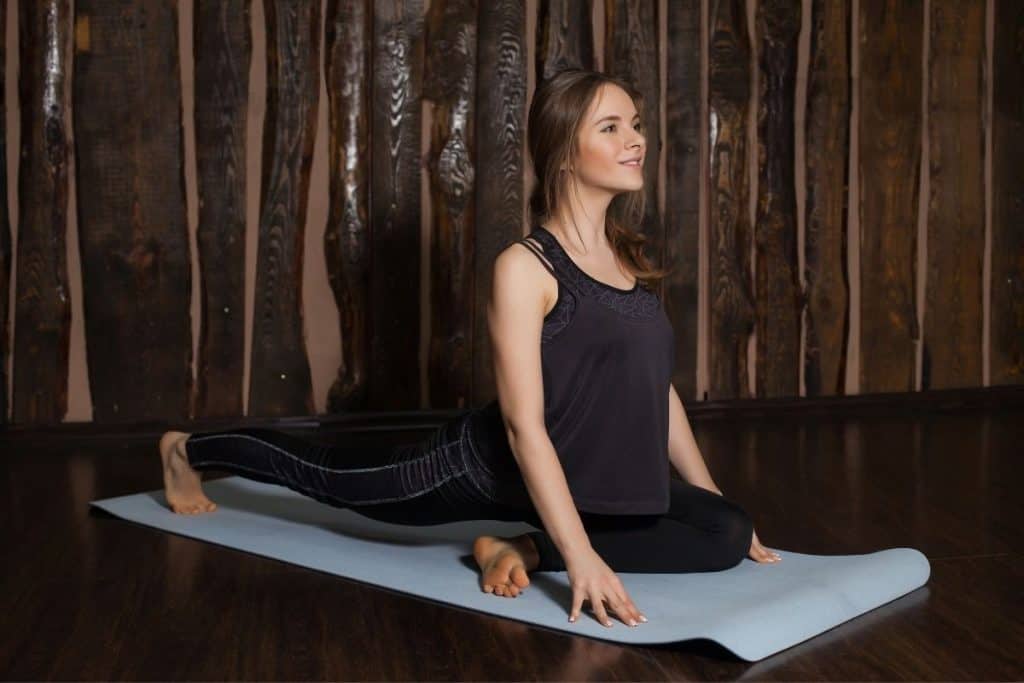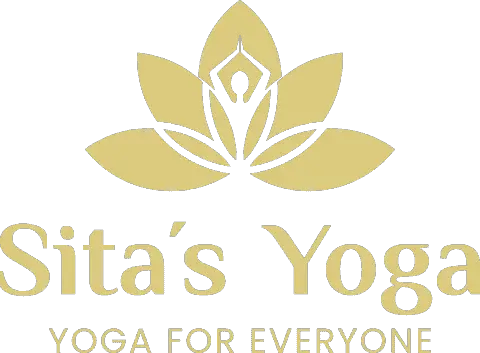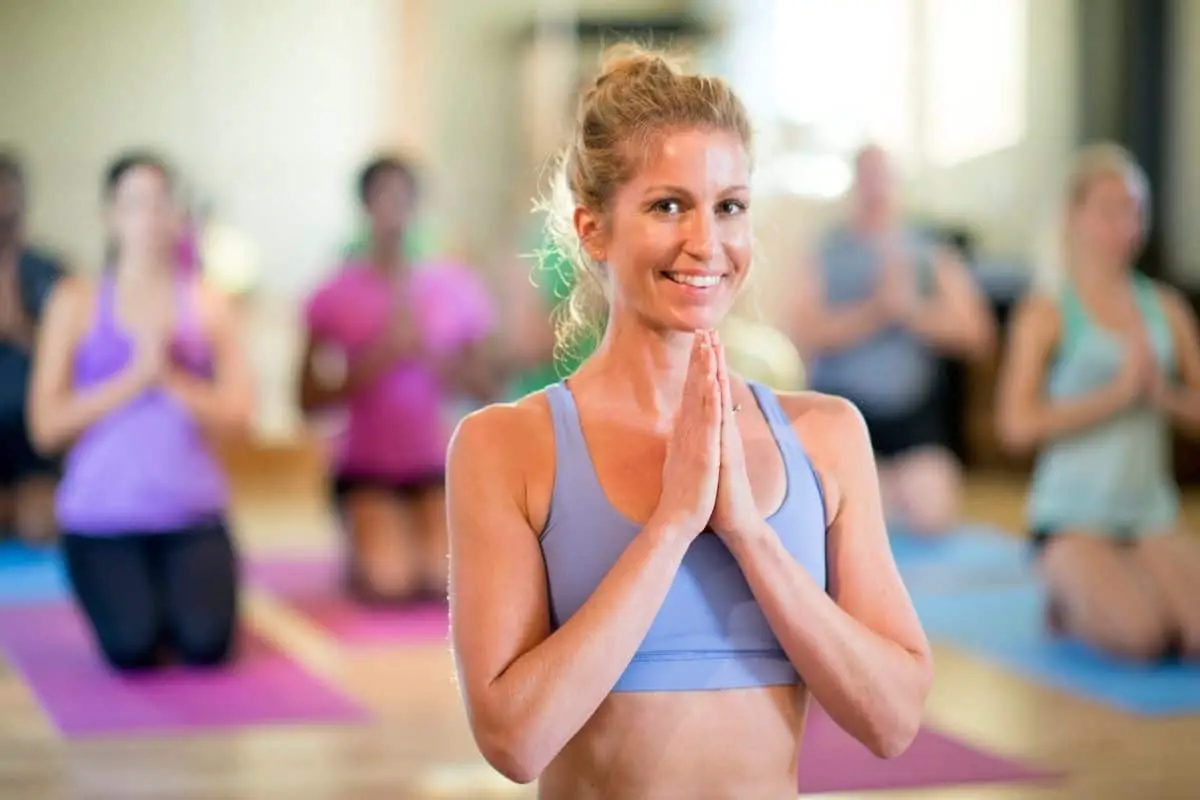The Lotus Pose, or padmasana, creates a challenge for many yogis. Even after spending a considerable amount of time deepening one’s practice and opening up the body to greater flexibility, many yogis still find it a challenge to sit in a full Lotus position. While hip flexibility is a contributing factor to the ability to do the Lotus position, there are a variety of other factors that influence this posture’s accessibility to its practitioner as well.
You may not be able to sit in a full lotus position due to a variety of reasons, including the amount of soft tissue flexibility in your hips, how your femur connects to your hip socket, knee condition, age, activity level, genetic makeup, or even your own mindset.
Some of these factors can be remedied through further practice and exercises designed to open the hips and provide a greater range of motion in your joints. However, some factors, such as the bone structure in your hips, cannot be manipulated through exercises. The rest of the article will explore each of these reasons more thoroughly and provide exercises on improving what you can.
Anatomical Requirements to Arrive in Full Lotus
To sit in a full lotus position, you need to create space and flexibility in your hips and possess a normal range of motion in your knees. The emphasis is really on the hips because tightness you may be experiencing in your knees can often be traced back to tightness in the hips. Looking at the body in a holistic way, it’s important to understand what happens in one leg joint will impact the other joints as well.
Now that we know we need to better understand the hips to understand Lotus Pose obstacles let’s look at the three specific movements necessary for the Lotus position: flexion, abduction, and external rotation.
Flexion is usually the easy one. For anyone to sit down in a chair, your hips will flex to 90 degrees, which is not an issue for the average person. Abduction is usually okay as well; this refers to the motion of bringing the legs away from one another. The issue arises with the ability of the hips to rotate externally.
External Range of Motion in the Hips
According to the American Academy of Orthopaedic Surgeons, the average external range of motion for hips is between 0-45 degrees. Our average range of motion changes based on our age, activity level, gender, and genetics. This will be explored in greater detail later on.
In a study measuring the range of motion required for different sitting positions with patients in India, researchers gathered specific data about how open the hips are in different positions. When sitting in a position with the hips and knees at a 90-degree angle, the average amount of external rotation required was 40.7 degrees. While this means it is possible for some people, it is certainly at the very end of the spectrum for what is considered normal movement for adults.
Now let’s look at the anatomical factors that influence the hips’ external rotation: the first deals with soft tissue flexibility and can be improved through exercises and practice. The second has to do with your physical bone structure and cannot be changed, no matter how much flexibility you build.
Amount of Soft Tissue Flexibility in Your Hips
The good news is the first obstacle standing between you, and the full Lotus Position is something that you can improve through practice. The first problem you might be experiencing is that you do not have enough flexibility in your hip joint’s soft tissue. This will be experienced as tension and tightness in your hip region when attempting exercises that necessitate external hip rotation.
Soft tissue includes the muscles and ligaments in your hip joints, and these can be manipulated through yoga practices and other exercises. By focusing on exercises that are considered hip openers, you will be able to impact the amount of tension in the soft tissue in your hips. With time and practice, you will be able to open these up, creating more space and greater flexibility.
Unique Construction of Your Femur and Hip Socket
The second factor has to do with your unique and static bone structure. Our skeletons are quite unique to each of us, with “normal” structures being a composite of a wide variety of structures found in humans. Your bone structure cannot be changed, no matter how many hip opener exercises you perform.
The most relevant part of the skeleton for the Lotus Pose is your femur bone and your hip socket. How they connect creates a factor known as compression, which impacts Lotus’s range of motion. Let’s take a closer look at this factor here.
Hip Sockets
Hip Sockets vary in size, depth, and position. Some hip sockets are positioned in a way that is pointing more towards the front of the body. These types are considered to have anteversion. If the hip sockets lack anteversion, they will be facing more towards the side of the body. Your hip sockets’ position will directly impact how much external hip rotation you can perform.
Another interesting fact about hip sockets is that they are not necessarily the same on each side of the same person. You may have had the experience that it is easier to do half lotus with one of your legs than the other. This is most likely because the hip socket on that side of your pelvis is positioned in a way that allows for more external hip rotation.
Femurs
The next anatomical factor when it comes to external hip rotation is the femur. Femurs are widely variable depending on the person. There is a range of angles that they will connect to the hip sockets in. For example, retroversion femurs are built at a slightly downward angle, while anteversion hip sockets are designed to be positioned significantly upward. The design of the femur will directly impact how much external rotation the hip can perform.
Considering the construction of your hip socket and femur will dictate how much external rotation your body is capable of. However, you will likely make up what you lack with external rotation in internal rotation. If you struggle to perform positions where a lot of external rotation is required, you will likely be quite good at positions where you need a lot of internal rotation.
Normal Range of Motion in the Knees
Even though the knees are also involved in this position, the flexibility of the hips impacts how much the knees must rotate to sit comfortably. If your hips are tight, this can translate to feeling it in your knees. Therefore, it always comes back to the question of hip flexibility, even when thinking of seemingly knee-specific issues.
Knees should be able to perform a normal range of motion, which can be done when the knee is bent. If the knee has been bent anywhere between 30 and 90 degrees, it becomes possible for lateral rotation to occur. This is the type of rotation you will need to sit in Lotus.
Activity Level, Gender, and Age on Range of Motion
Now that we better understand the range of motion necessary in your body to access the Lotus Pose, we can now see some other factors that will influence how your range of external hip rotation fits into the average.
Keep in mind that these are general trends, not absolutes. Typically, women have a slightly greater range of external rotation when compared to men. The younger the individual, man or woman, typically, the more range of motion they will naturally have. And lastly, the more activity a person performs to keep the hips open and flexibly will give them a greater range of motion in these joints.
Genetics and Culture on Range of Motion
Genetics and cultural context also impact the body, especially in hip flexibility. In Eastern Cultures, daily activities are much more beneficial to keep the hip joints open than daily activities in the West. For example, sitting in chairs at desks or tables does not give the hips any chance to flex. Therefore, many Westerners have a more limited range of motion due to how they sit to work, eat, and relax.
On the other hand, in the East, sitting on the floor, sitting cross-legged, and squatting down are incredibly normal parts of everyday life. By assuming these types of positions throughout the day, every day, the hip joints in people from Eastern cultures are more likely to stay open and remain more flexible throughout their lives.
Mindset

A final influence on your ability to sit in Lotus is how you are approaching the position. By forcing or rushing, likely, you will not be able to do the position, even if your body is fully capable. It is one of the many lessons that yoga teaches us to approach the practice in a way we are not used to doing in our busy, goal-oriented lives.
Any advanced yoga position is not meant to be achieved immediately but is meant to guide your path to a deeper practice. It is less a matter of black and white, can or cannot do the position, but rather how are you preparing to enter that position eventually? How is the journey of learning how to sit in padmasana teaching you more about your own body and your own experience?
By slowing down and properly exploring the necessary exercises to prepare your body for more advanced postures, you are also more adequately preparing your mind as well. You are bringing acceptance, patience, and curiosity onto your mat, which are, in some ways, just as necessary as flexibility.
How to Prepare Yourself for Lotus
Wherever you are in your practice, now we can look at some ways you can start to prepare yourself physically for the full lotus position. Even if you think your bone structure isn’t built for the kind of hip rotation you will need for the pose, you can still use this guide to deepen your practice even if you are only looking to achieve a half lotus or another modified posture.
As you begin to open your hips and build flexibility in this area, remember that there are several different areas to be working on. A lot of focus will fall on the outer hip muscles, but not exclusively. It is important to stretch all of the muscles that come into contact with the hip socket.
Target Muscle Groups
When we tend to think of hip openers, we might think of a pose like Pigeon Pose that really focuses on the external rotators, gluteus maximus, and hip flexors. However, other muscle groups will also help the flexibility in the hips.
These additional muscles include adductors, abductors, and hamstrings. These are perhaps less obvious muscles to include in your journey to a comfortable lotus but are still important to be able to arrive safely without unnecessarily pulling on the knees.
Without properly developing openness and flexibility in all involved muscle groups, both obvious and less conspicuous, you are likely to experience discomfort or inability to sit in Lotus.
Let’s take a look now at some yoga postures that will help you develop the soft tissue flexibility required for this position.
Crescent Moon Pose (Anjaneyasana)
This lunge is a beautiful pose to open up your hip flexors. The Crescent Moon Pose is a low lunge that will give you a gentle opportunity to begin your journey of hip opening.

How to Do the Crescent Moon Pose
To move into this posture, you can begin in Downward Facing Dog. From there, lift your right leg off the ground, and step it forward between your hands. Once your right foot is planted next to your right hand, you may rearrange your left leg, placing the top of your foot on the mat and your left knee gently on the ground.
From here, breathing deeply, lift your heart and your gaze up. Feel your left foot sinking into the floor and your hip points shining forward. You can even lift your arms overhead, bringing your gaze up to the sky as well. Breathe here, focusing on the sensation in your hips, particularly in your left hip.
After a few cycles of breath in the position, you can bring your arms and gaze back to the mat, stepping back into Downward Facing Dog. Repeat, this time stepping your left foot forward and sinking your right knee and top of the right foot into the mat.
Further Variations of the Crescent Moon Pose
When you are in Anjaneyasana, you can deepen this position by adding a quadricep stretch. With the right foot forward and the left knee on the ground, bring your torso up, so your heart is opening forward, and your gaze is straight ahead.
From here, gently bring your left arm back while lifting your left foot. Grasp the left foot with the left hand and engage the quadriceps in a deep stretch. Your hips, torso, and head will remain facing forward. You may need to move your front foot up slightly to feel this stretch fully.
This can be repeated on the other side as well.
Wide-Legged Forward Fold (Prasarita Padottanasana I)

This pose is a great way to open up some of your leg muscles to aid your Lotus Position. By generously sinking into this forward fold, you will be giving your adductors (found on the insides of your upper thighs) and hamstrings (located on the back of your upper thighs) a chance to stretch out.
How to Do the Wide-Legged Forward Fold
Begin by standing on your mat, facing one of its long sides. Step your feet out wide, so they are beyond the line of shoulders. You can step out to about 3.5-4 feet (approximately 1 meter), depending on your size and structure. Once your feet are widely placed at a comfortable distance, place your hands on your hips.
On an exhale, lower your torso and head down to become perpendicular with your legs. Your back should remain straight and long, not curling down. Bring your hands down to the mat, stretching your arms out. With straight arms, a straight back, and straight legs, you should be forming ninety-degree angles where your limbs meet the mat as well as where your back meets your hips.
Deepening the Stretch
Depending on your body, this might be enough for you. Feel free to pause here, breathing deeply into your upper thighs. If you seek more of a stretch, you can walk your hands back a bit and envision the crown of your head moving towards the ground. Your back and neck should remain long and straight, with the fold coming from your pelvic area as opposed to somewhere in your back.
Even if your head is nowhere near touching the mat, holding this position while breathing deeply will do wonders for your upper thigh muscles. Remember to keep your feet firmly planted on the ground and do your best not to let your weight shift too far back, releasing the stretch from its target of your hamstrings.
Wide-Legged Yogic Squat (Malasana)

By sinking down into this yogic squatting position, you have the opportunity to release tension stored in the adductors and create more space in these muscles. Especially for Westerners who do not spend so much time in a squatting position, this pose provides an opportunity to engage in this position much used throughout daily life in Asia.
How to Do a Yogic Squat
There are a few variations of this pose that will help engage all levels of yogis. The essential position involves moving from a wide-legged stance into a squat, keeping the back straight, and the gaze forward. To increase your groin region stretch, bring your hands together in front of your heart in Anjali Mudra. Your elbows should be inside of your bent knees. You can gently use the pressure of your elbows to push your squat out wider.
Deepening the Stretch
If you are seeking additional stretch in your groin, you can add a block between your hands, either lengthwise or widthwise. This will add to the distance between your hands in Anjali Mudra, allowing you to naturally and gently push your squat open even wider, giving your groin a deep stretch.
If this is too much for your body, you could use the block underneath your bottom as support. By resting on the block, you will be able to slowly and gradually begin to open your hips and sink deeper into the squat over time.
Butterfly Pose (Bhadrasana)

Butterfly Pose is another wonderful stretch for the hips and thighs and is a staple of many yoga classes. This pose also is a great remedy for spending too much time sitting in chairs. It specifically helps stretch out the hip flexors, which often become too tight from spending countless hours sitting in an upright position as we would on a chair.
How to Do the Butterfly Pose
Sitting in a comfortable seat on your back, with your spine straight, bring the soles of your feet together in front of you. Depending on your flexibility level, you may be able to bring your feet very close to your inner thighs, or there may be some distance between them. Either way, find a place that feels good for you and your body.
From here, keeping your back straight, slowly begin to fold forward at the hips, lowering your torso down. There should not be too much bend coming from your mid-back; the bend should be coming from where your torso meets your hips.
Find your edge in this position, breathing deeply into the stretch. When you are ready, slowly release and come back to a simple seated position.
Simple Pigeon Pose (Variation of Eka Pada Rajakapotasana)

Moving into a simple pigeon position is a wonderful hip opener. If you have tried this pose in class, you can probably recall the tension of moving into it and the beautiful release that comes with resting in it. While the Pigeon Pose we are all most familiar with is a simpler version of an advanced backbend, it is still a wonderful and central hip opener for anyone looking to progress in hip flexibility.
How to Do the Simple Pigeon Pose
Begin in Downward Facing Dog. From here, lift your right leg up in order to bring it forward, as if you were stepping between your hands as in the low lunge. However, instead of planting your foot firmly on the mat, you will bend your knee, bringing it down on the mat near your right hand. This should place your right foot somewhere near your left hand or angled further back, depending on your flexibility.
Now bring your attention to your left leg. Slowly bring your knee down to the mat. Both of your hips should be pointing forward while your left leg is pointing straight back. Breathe into this stretch, especially into your right hip crease.
Deepening the Stretch
If you are comfortable in the position as it has been described so far, you can deepen the stretch by slowly folding forward. You can begin by coming down onto your elbows, continuing to breathe into your hips. If it’s possible and comfortable, you may continue all the way down, so your arms and head are comfortably resting on the mat. Remember to keep your hips square and pointing forward.
Wherever you are in your pigeon pose, remember to breathe deeply. Imagine yourself breathing into the points of your body where you feel the stretch. This is key to bringing oxygen to these areas, allowing the muscles to gain openness and release the tension you will initially feel.
To come out of this Simple Pigeon Pose, use your hands to help move your torso upright again. From here, you can lift the back leg so your toes are gripping the mat again and step back into the Downward Facing Dog. Repeat this pose on the other side, stretching the other hip.
Preparing Your Mindset
Remember, with all of these postures; it is most important to approach them in a harmonious, peaceful way. This means to embrace rather than resist any physical limitations you are experiencing and come back to these poses each day as a way to facilitate your journey on the yoga mat.
Remember to perform any pose that you are practicing in a comfortable way, gently coming to your own edge in the position without pushing yourself too far. Take each pose as a chance to listen to your body and find greater harmony between what your body is telling you and what your mind is telling it to do.
Final Thoughts
Now that we have gained a greater understanding of the Lotus Position’s physical requirements, we are better equipped to prepare for this advanced posture. By changing what is possible to change through a deeper practice and accepting what is unchangeable in terms of our bone structure and genetics, we are better prepared in both our body and mind to practice padmasana.
Sources
- Get Healthy U: How To Do Butterfly Pose
- Glo: Yoga Anatomy in Action
- National Library of Medicine: Clinical Evaluation of Hip Joints
- Spotebi: Low Lunge Quad Stretch Pose
- Very Well Fit: How to Do Pigeon Pose
- Yoga Anatomy: Is Lotus Pose Anatomically Possible?
- Yoga Journal: 6 Steps to Master Prasarita Padottanasana
- Yoga Journal: How Yogis Do Squat
- Yoga Journal: Learn More About Anjali Mudra
- Yoga Journal: Low Lunge
- Yoga Journal: Wide-Legged Forward Bend
- Yoga International: 5 Tips for Building Your Lotus Pose
- Yoga International: Lotus Position: Destroyer of Disease, or Destroyer of Knees?
Sitasyoga.com is a participant in the Amazon Services LLC Associates Program, an affiliate advertising program designed to provide a means for sites to earn advertising fees by advertising and linking to Amazon.com. We also participate in other affiliate programs which compensate us for referring traffic.




